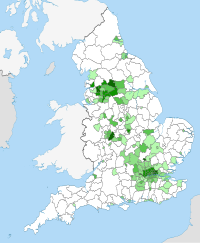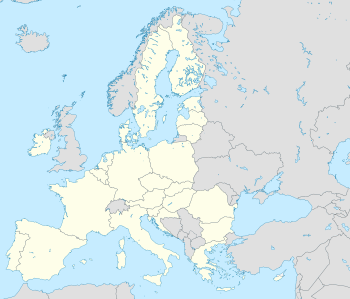Daftar kota di Uni Eropa berdasarkan jumlah populasi Muslim
Islam adalah agama yang tercepat perkembangannya di Eropa, terutama disebabkan oleh imigrasi.[1][2]

Sejak tahun 1960-an, imigran dari negara-negara Muslim mulai datang di berapa negara di Eropa Barat, terutama di Jerman, Prancis dan Belgia. Selain itu terdapat komunitas Muslim yang besar dan telah ada di benua Eropa sejak penaklukan Ottoman pada akhir Abad Pertengahan, terutama di Balkan. Ini adalah gelombang besar pertama dari imigrasi Muslim ke Eropa barat laut.[3]
Muslim di Eropa bukan kelompok homogen. Mereka dari berbagai nasional, etnis dan ras identitas. Sebagian besar Muslim di Eropa Barat berasal dari Turki, Maghreb (termasuk Maroko dan Aljazair), dan Asia Selatan (termasuk Pakistan dan Afghanistan).[4]
Di Eropa Barat, umat Islam umumnya tinggal di kota-kota besar dan terkonsentrasi di daerah miskin.[5]
Menurut Pew Forum, jumlah Muslim di Eropa pada tahun 2010 berjumlah sekitar 44 juta (6%).[6] Sedangkan jumlah Muslim di Uni Eropa pada tahun 2010 adalah sekitar 19 juta (3.8%). Ibu kota Prancis Paris dan wilayah metropolitan sekitarnya memiliki jumlah terbesar (hingga 1,7 juta menurut para Ekonom)[7] umat Islam di luar dari kota manapun di Uni Eropa. London juga memiliki sejumlah besar komunitas Muslim asli dengan jumlah sekitar 1 juta di London raya dan jumlah ini bisa lebih apabila seluruh area metropolitan diperhitungkan.
Pada tahun 2030, orang-orang yang beragama Islam diprediksi akan membentuk sekitar 10% dari penduduk Prancis dan 8% dari populasi Eropa.
Tabel di bawah ini daftar kota-kota besar di Uni Eropa dengan populasi Muslim yang signifikan, beberapa memperkirakan persentase umat Islam dengan menggunakan persentase jumlah orang Asia di kota-kota tersebut.
Referensi sunting
- ^ Nachmani, Amikam (2010). Europe and its Muslim minorities: aspects of conflict, attempts at accord. Brighton: Sussex Academic. hlm. 35. ISBN 9781845194000.
- ^ Cherribi, Sam (2010). In the house of war: Dutch Islam observed. Oxford: Oxford University Press. hlm. 33. ISBN 9780199734115.
- ^ Barrett, Darcy M. (2008). Concepts of Identity and the Islamitization of Europe: The Components of Growth and Radicalization of the Global Salafi Islamic Movement in Europe and Its Implications for the West. ProQuest. hlm. 60. ISBN 9780549970705.
- ^ a b c d e f Nydell, Margaret K. (2012). Understanding Arabs: a contemporary guide to Arab society. Boston, MA: Intercultural Press. hlm. 132. ISBN 9780983955801.
In 2011 they constituted 25 percent of Rotterdam andMarseilles; 20% of Malmo; 15 percent of Amsterdam, Brussels and Birmingham; 90% of Sarajevo; and 10 percent of London, Paris, Copenhagen, and Vienna.
Muslims in Western Europe originate from both Arab and non-Arab countries. Those in the United Kingdom are primarily from South Asia, in France from North and West Africa, in Germany from Turkey, in Belgium from Morocco, and in the Netherlands from Morocco and Turkey. - ^ a b c d Farmer, Brian R. (2010). Radical Islam in the West: ideology and challenge. Jefferson, N.C.: McFarland & Co. hlm. 8. ISBN 9780786459537.
Muslims living in the West are also concentrated in urban area. Muslims are currently estimated to compose almost one-fifth of the population of Marseilles, and 15 percent of Paris, Brussels, and Birmingham. Muslims are currently make up approximately 10 percent of the populations in London and Copenhagen.
- ^ Pew Forum, The Future of the Global Muslim Population, January 2011, "Archived copy". Diarsipkan dari versi asli tanggal 23 March 2012. Diakses tanggal 2012-09-18.
- ^ a b c d e "When islam claims to be the victim". The Economist. 4 December 2008. Diakses tanggal 28 January 2013.
see the chart [1]
- ^ a b c "Kerkelijkheid en kerkbezoek". Diakses tanggal 29 September 2017.
- ^ "Moslims in Brussel 2010–2030". npdata.be. 13 February 2012. Diakses tanggal 3 November 2013.
- ^ "Estademograf.pdf" (PDF). hispanomuslim.es. Observatorio.pdf. 31 December 2016. Diakses tanggal 29 September 2017.
- ^ "Ramadan in Refugee homes and Schools in Berlin". tagesspiegel.de. Diakses tanggal 29 September 2017.
- ^ a b c d e "Population of England, Wales and selected local authorities against numbers and percent of Muslims (2015 to 2016) 2017". Office for National Statistics. Diakses tanggal 17 April 2018.
- ^ Erasmus (15 October 2017). "In Belgium, arguments about Islam grow louder". The Economist. Diakses tanggal 9 November 2018.
- ^ Der Spiegel: "Dialog mit Außerirdischen". 25 March 2008, retrieved 20 April 2013.
- ^ Die Welt: "Moschee für Mülheim" Diarsipkan 2016-03-05 di Wayback Machine.. 1 February 2012. Retrieved 20 April 2013
- ^ Berliner Zeitung: "Kulturkampf in Köln" Diarsipkan 2015-09-24 di Wayback Machine.. 31 May 2007. Retrieved 20 April 2013
- ^ a b [2]
- ^ a b c d Micklethwait, John; Wooldridge, Adrian (2009). God is back how the global revival of faith is changing the world. New York: Penguin Press. ISBN 9781101032411.
Muslims are highly concentrated—they make up 24 percent of the population in Amsterdam; 20 percent in Malmo and Marseille; 15 percent in Paris, Brussels, Bradford, and Birmingham; and 10 percent or more in London and Copenhagen.
- ^ a b c d e [3]
- ^ Central Statistics Office - Population (Number) by Towns by Size, Sex, Religion and Census Year
- ^ "Muslime in Deutschland Landkreise". 2017-04-05. Diakses tanggal 29 September 2017.
- ^ "2011 Census: Religion, local authorities in England and Wales". United Kingdom Census 2011. Office for National Statistics. Diakses tanggal 12 December 2012.
- ^ a b "Being Muslim in France" (PDF). Brookings Institution. hlm. 22. Diakses tanggal 16 February 2013.
- ^ Erlanger, Steven (27 December 2009). "French Mosque's Symbolism Varies With Beholder".
- ^ https://www.op-online.de/offenbach/offenbach-prozent-sind-muslime-4648763.html
- ^ "A French Town Bridges the Gap Between Muslims and Non-Muslims". New York Times. Diakses tanggal 5 August 2013.
- ^ "Vienna: share of Catholics halved since 1970s". diepresse.com. August 2014. Diakses tanggal 29 September 2017.

